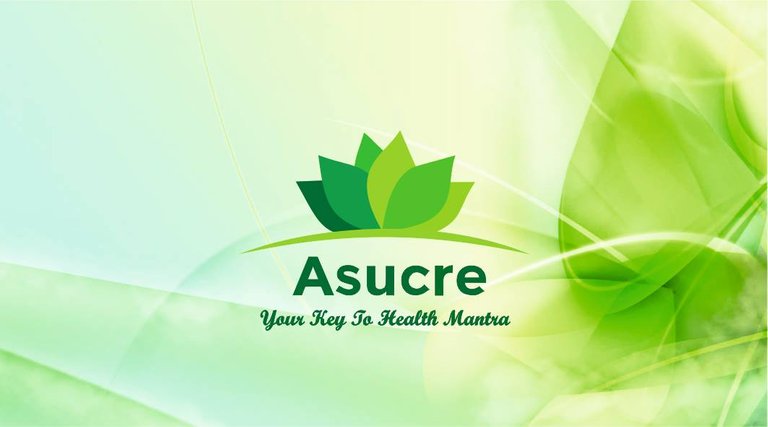Asucre ASTAXANTHIN contains natural Astaxanthin from the microalgae Haematococcus pluvialis and a natural carotenoid that can be found from arctic marine environments, to common fresh water rock pools throughout the world. Because Haematococcus often grows in places that are exposed to intense sunlight during its dormant phase, Astaxanthin functions to protect the cell nucleus against free radicals generated by UV radiation that would otherwise cause damage to its DNA and peroxides energy reservoirs.
In Asucre ASTAXANTHIN, a xanthophyll carotenoid is a nutrient with unique cell membrane actions and diverse clinical benefits. This molecule neutralizes free radicals or other oxidants by either accepting or donating electrons, and without being destroyed or becoming a pro-oxidant in the process. Its linear, polar-nonpolar-polar molecular layout equips it to precisely insert into the membrane and span its entire width. In this position, Astaxanthin can intercept reactive molecular species within the membrane’s hydrophobic interior and along its hydrophilic boundaries. Clinically, Astaxanthin has shown diverse benefits, with excellent safety and tolerability.
Natural Astaxanthin has a unique molecular structure that makes it literally hundreds of times stronger than any other antioxidant molecule. For this reason, Astaxanthin is often called “The King of Antioxidants”.
Astaxanthin has several essential biological functions including protection against oxidation of essential polyunsaturated fatty acids; protection against UV light effects; immune response; pigmentation; communication; reproductive behavior and improved reproduction. Some microorganisms are rich in Astaxanthin – the Chlorophyte alga Haematococcus pluvialis is believed to accumulate the highest levels of Astaxanthin in nature.
Astaxanthin is closely related to other well-known carotenoids, such as b-carotene, zeaxanthin and lutein, thus they share many of the metabolic and physiological functions attributed to carotenoids. The presence of the hydroxyl and keto endings on each ionone ring, explains some unique features, such as the ability to be esterified, a higher anti-oxidant activity and a more polar configuration than other carotenoids. Free Astaxanthin is particularly sensitive to oxidation. In nature, it is found either conjugated to proteins, such as in salmon muscle or lobster Exoskeleton, or esterified with one or two fatty acids, which stabilize the molecule. In H. pluvialis, the esterified form predominates, mostly as Astaxanthin monoester.
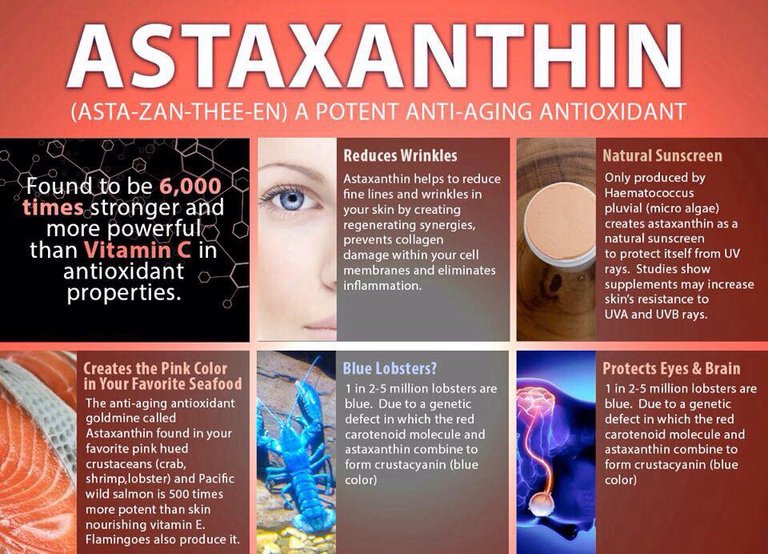
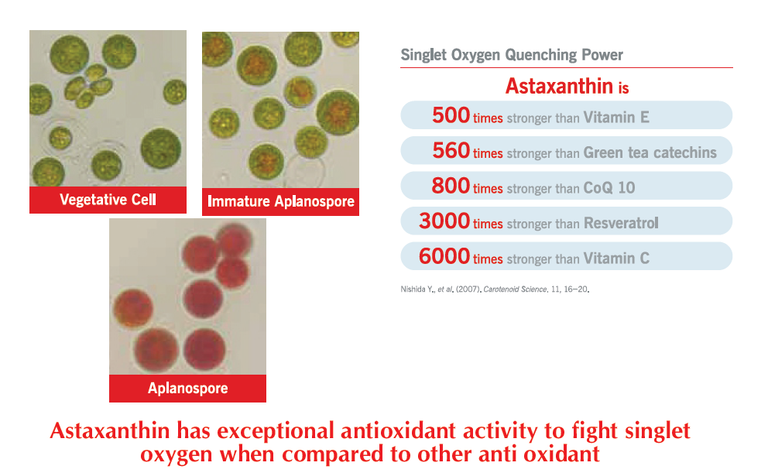
Various Astaxanthin stereoisomers are found in nature that differs in the configuration of the two hydroxyl groups on the molecule. The 3S, 30S stereoisomer is the main form found in H. pluvialis and in wild salmon. Astaxanthin cannot be synthesized by animals and must be acquired from the diet. Although mammals and most fish are unable to convert other dietary carotenoids into Astaxanthin, crustaceans (such as shrimp and some fish species including koi carp) have a limited capacity to convert closely related dietary carotenoids into Astaxanthin, although they benefit from being fed Astaxanthin directly. Mammals lack the ability to synthesize Astaxanthin or to convert dietary Astaxanthin into vitamin A: unlike bcarotene, Astaxanthin has no pro-vitamin A activity in these animals.
ROLE OF ASTAXANTHIN CAPSULES AS MOTHER’S NATURE MOST POWERFUL ANTIOXIDANT
NEUROVASCULAR PROTECTION: Decrease the oxidation of Red blood cells, decreases the incidence of ischemic stroke, and improves memory and learning.
SKIN AGING DEFENSE: Prevents UV induces wrinkle formation, skin sagging, and age spots; improves skin elasticity and skin dryness.
LIVER HEALTH and METABOLIC SYNDROME: Inhibits progression of fatty liver disease, increases fat burning, and decreases inflammatory markers.
LOWERING GASTRIC INFLAMMATION: Reduces Helicobacter pylori inflammation, gastric ulceration, indigestion, acid reflex, and heart burn and stomach pain.
MUSCLE RESILIENCE: Enhances power output, endurance, and recovery after exercise; prevents muscle damage and muscle atrophy.
EYE FATIGUE RELIEVE: Reduces eye fatigue in subjects suffering from visual display syndrome.
IMMUNE SYSTEM BOOSTER: Reduces DNA damage in immune cells and enhances the immune response.
CARDIOVASCULAR HEALTH: Fights atherosclerosis by decreasing blood pressure, lipid deposits, lipid per oxidation and vascular inflammation.
ANTI-DIABETES: Improves pancreatic function, insulin resistance, and insulin sensitivity.
KIDNEY PROTECTION: Reduces glucose toxicity and kidney inflammation.
FERTILITY: Improves sperm parameters and fertility.
CAPILLARY CIRCULATION: Improves blood flow and capillary integrity; reduces blood cell oxidation and the risk of thrombosis.
BIOAVAILABILITY AND PHARMACOKINETICS - The various steps of digestion, absorption and plasma transport of dietary carotenoids in mammals have been reviewed. In the plasma, non-polar carotenoids such as b-carotene, a-carotene or lycopene, are mostly transported by very low density lipoproteins (VLDLs) and low density lipoproteins (LDLs) and polar carotenoids, such as zeaxanthin or lutein, are more likely to be transported by LDLs and high density lipoproteins (HDLs). The only study on humans to date confirmed the bioavailability of Astaxanthin supplied in a single high dosage of 100 mg and its transport in the plasma by lipoproteins.
Astaxanthin as antioxidant Free radicals (e.g. hydroxyl and peroxyl radicals) and highly reactive forms of oxygen (e.g. singlet oxygen) are produced in the body during normal metabolic reactions and processes. Physiological stress, air pollution, tobacco smoke, exposure to chemicals or exposure to ultraviolet (UV) light, can enhance the production of such agents. Phagocytes can also generate an excess of free radicals to aid in their defensive degradation of the invader. Free radicals can damage DNA, proteins and lipid membranes. Oxidative damage has been linked to aging, atherogenesis, ischemia-reperfusion injury, infant retinopathy, age-related macular degeneration and carcinogenesis.
Dietary antioxidants, such as carotenoids, might help to prevent and fight several human diseases. Carotenoids are potent biological antioxidants that can absorb the excited energy of singlet oxygen onto the carotenoid chain, leading to the degradation of the carotenoid molecule but preventing other molecules or tissues from being damaged. They can also prevent the chain reaction production of free radicals initiated by the degradation of poly-unsaturated fatty acids, which can dramatically accelerate the degradation of lipid membranes. Astaxanthin is very good at protecting membranous phospholipids and other lipids against peroxidation.
Astaxanthin antioxidant activity has been demonstrated in several studies. In some cases, Astaxanthin has up to several-fold stronger free radical antioxidant activity than vitamin E and b-carotene. The antioxidant properties of Astaxanthin are believed to have a key role in several other properties such as protection against UV-light photo oxidation, inflammation, cancer, ulcer’s Helicobacterpylorii infection, aging and age-related diseases, or the promotion of the immune response, liver function and heart, eye, joint and prostate health.
ASTAXANTHIN AS A PHOTO PROTECTANT - Exposure of lipids and tissues to light, especially UV-light, can lead to production of singlet oxygen and free radicals and photo-oxidative damage of these lipids and tissues. Carotenoids have an important role in nature in protecting tissues against UV-light mediated photo-oxidation and are often found in tissues directly exposed to sunlight. Astaxanthin can be significantly more effective than b-carotene and lutein at preventing UV-light photo oxidation of lipids. Oxidative damage to the eye and skin by UV light has been widely documented and thus the unique UV protection properties of Astaxanthin could be very important for eye and skin health.
ASTAXANTHIN AND EYE HEALTH - Two of the leading causes of visual impairment and blindness are age-related macular degeneration (AMD) and age-related cataracts. Both diseases appear to be related to light-induced oxidative processes within the eye. It is therefore not surprising that factors related to oxidation have been shown in epidemiological studies to be related to an elevated risk for AMD. A high dietary intake of carotenoids, specifically lutein and zeaxanthin (from spinach, kale, and other leafy green vegetables) is associated with a reduced risk for both nuclear cataracts and AMD. Lutein and zeaxanthin, two carotenoid pigments closely related to Astaxanthin, are concentrated in the macula of the eye.
The structure of Astaxanthin is very close to that of lutein and zeaxanthin but has a stronger antioxidant activity and UV-light protection effect. Astaxanthin has not been isolated in the human eye. However, an animal study demonstrated that Astaxanthin is capable of crossing the blood–brain barrier and, similar to lutein, will deposit in the retina of mammals. The retinal photoreceptors of rats fed Astaxanthin were less damaged by a UV-light injury and recovered faster than animals not fed Astaxanthin. Therefore, it can be inferred that deposition of Astaxanthin in the eye could provide superior protection against UV light and oxidation of retinal tissues pointing to the potential of Astaxanthin for eye health maintenance.
ASTAXANTHIN AND SKIN HEALTH - Excessive exposure of unprotected skin to sunlight results in sunburn and can also lead to photo-induced oxidation, inflammation, immunosuppression, aging and even carcinogenesis of skin cells. Pre-clinical studies show that typical dietary antioxidants, such as a-tocopherol, ascorbic acid or b-carotene, could reduce such damage. Astaxanthin is believed to protect the skin against UV-light photo-oxidation. Astaxanthin supplementation helped protect the retinal photoreceptors in the eyes exposed to acute UV-light injury and the in vitro protective effect of Astaxanthin against UV-induced photo oxidation was stronger when compared with b-carotene and lutein. These findings suggest that Astaxanthin has an excellent potential as an oral sun-protectant. Although diet supplementation with b-carotene or Astaxanthin has demonstrated benefits in other types of cancer, the animal or clinical studies with these two compounds are inconclusive when it comes to skin cancer. More studies are needed to better understand the possible interactions between various antioxidants and their potential pro-oxidative role, to determine under which conditions supplementation with carotenoids such as Astaxanthin can help reduce skin carcinogenesis.
ASTAXANTHIN AND INFLAMMATION - In inflammation-related clinical conditions such as Crohn’s disease, toxic reactive oxygen species (ROS) are released by phagocytic leucocytes at the site of inflammation (intestinal mucosa and lumen). These, plus increased concentrations of neutrophils at the site of inflammation, create a pro-oxidative balance that leads to lower levels of antioxidant vitamins and increased levels of markers of oxidative stress and lipid peroxidation. Furthermore, oxidants have been directly linked to the stimulation of inflammation genes in endothelial cells. Similarly, ROS have been attributed an aggravating role in the inflammation that accompanies asthma and exercise-induced muscle damage.
More recently, dietary Astaxanthin was found to help fight symptoms of ulcer disease from Helicobacter pylori. Astaxanthin reduced symptoms of gastric inflammation and was also associated with shifts in the inflammation response. Although it could be assumed that the antioxidant properties of Astaxanthin explain its anti-inflammatory activity, further studies are needed to better understand the specific mode of action of Astaxanthin in fighting Inflammation.
ASTAXANTHIN AND HEART HEALTH - High blood levels of LDL-cholesterol (the ‘bad’ cholesterol) are associated with an increased risk of atherosclerosis. However, HDL blood levels are inversely correlated with coronary heart disease and are indicative of protection against atherosclerosis. Usually LDL in plasma is not oxidized and oxidation of LDL is believed to contribute to the development of atherosclerosis thus it might be possible to reduce the risk of atherosclerosis by antioxidant supplementation. Epidemiological and clinical data indicate that dietary antioxidants might protect against cardiovascular disease.
Astaxanthin is carried by VLDL, LDL and HDL in the human blood. An in vitro test and a study with human subjects ingesting daily dosages as low as 3.6 mg Astaxanthin per day for two consecutive weeks demonstrated that Astaxanthin protects LDL-cholesterol against induced in vitro oxidation. In an animal model study, Astaxanthin supplementation led to an increase in blood levels of HDL, the form of blood cholesterol inversely correlated with coronary heart disease. Thus, Astaxanthin could benefit heart health by modifying blood levels of LDL and HDL cholesterol. Finally, Astaxanthin could also be beneficial to heart health by reducing inflammation presumably associated with the development of coronary heart disease.
ASTAXANTHIN AND DIABETES
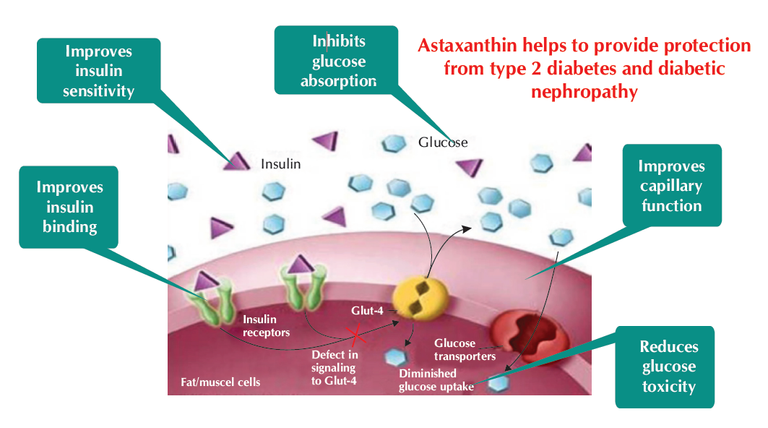
ASTAXANTHIN AND CELLULAR HEALTH - In the mitochondria, multiple oxidative chain reactions generate the energy needed by the cell but produce large amounts of free radicals that need to be neutralized to maintain proper mitochondrial function. It is hypothesized that the cumulative oxidative damage to mitochondria is the main culprit for the senescence of cells, which in turn is responsible for aging. The efficacy of Astaxanthin in preventing in vitro peroxidation of mitochondria of liver cells can be as high as 100 times that of vitamin E.
This highlights the unique capacity of Astaxanthin in helping to preserver mitochondrial functions and its unique potential in the fight against aging. Astaxanthin superior role in protecting cellular membranes is believed to derive from its ability to protect both the inner part and external surface of membranes against oxidation (a result of the moieties of its polyene chain and terminal rings as well as of rigidifying membranes and modifying their permeability).
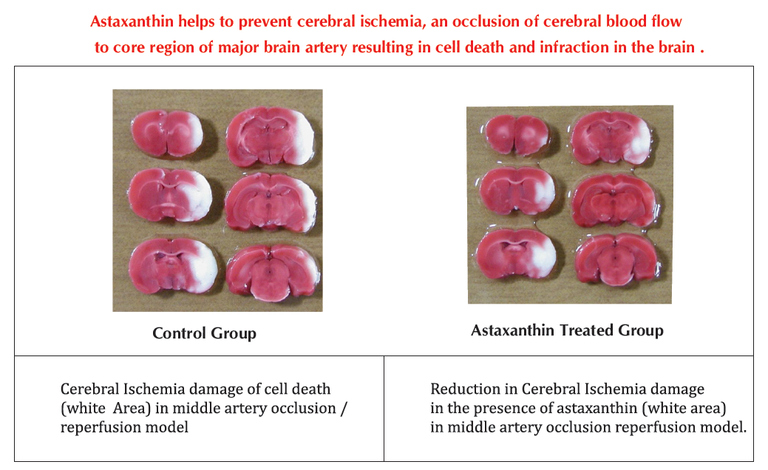
Antioxidants, carotenoids in particular, are not only essential to cellular health because they help protect cellular components against oxidative damage but also because they have a role in regulating gene expression and in inducing cell-to-cell communications. Recently, Astaxanthin was reported to have a role in regulating CYP genes in rat hepatocytes, although it did not seem to have that effect in human hepatocytes. Also carotenoids are active inducers of communication between cells at the cell-gap junctions (the water-filled pores in the cell membranes that permit cell-to- cell communications needed to modulate cell growth and, in particular, to limit expansion of cancerous cells). Thus, it is hypothesized that carotenoids affect DNA regulating RNA responsible for gap-junction communications and that this role in cell-gap junction’s communications might explain some of the anti-cancer activities of Astaxanthin.
HELP TREATS NEURO-DEGENERATIVE DISEASES
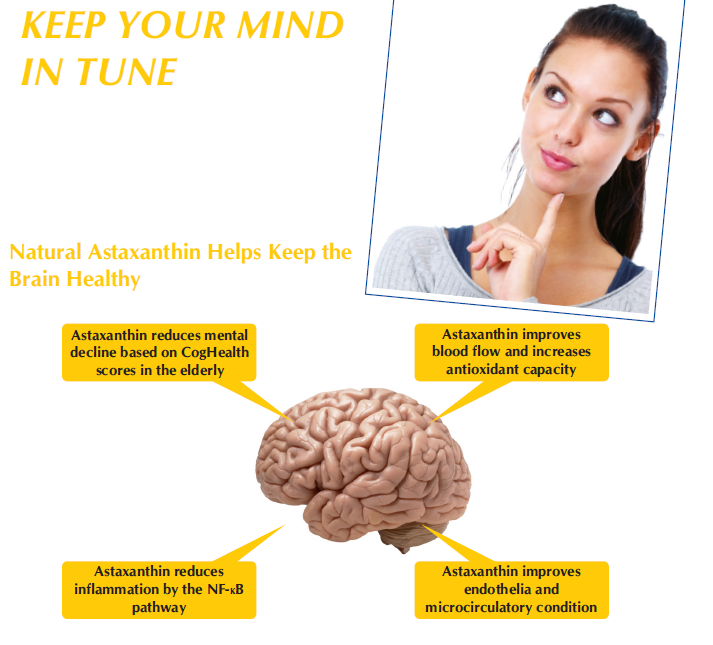
The nervous system is rich in both unsaturated fats (which are prone to oxidation) and iron (which has strong pro-oxidative properties). These, together with the intense metabolic aerobic activity and rich irrigation with blood vessels found in tissues of the nervous system, make tissues particularly susceptible to oxidative damage. There is substantial evidence that oxidative stress is a causative or at least ancillary factor in the pathogenesis of major neurodegenerative diseases (Alzheimer’s, Huntington’s, Parkinson’s and amyotrophic lateral sclerosis, ALS) and that diets high in antioxidants offer the potential to lower the associated risks. Astaxanthin can cross the blood brain barrier in mammals and can extend its antioxidant benefits beyond that barrier.
ANTI-CANCER PROPERTIES - Several studies have demonstrated the anti-cancer activity of Astaxanthin in mammals. Astaxanthin protected from carcinogenesis of the urinary bladder by reducing the incidence of chemically induced bladder carcinoma.
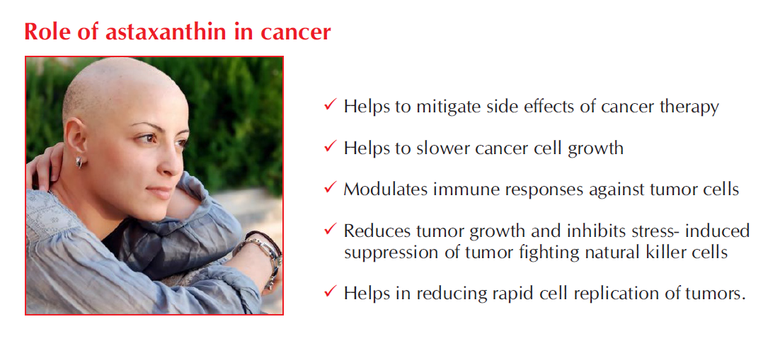
Dietary Astaxanthin is also effective in fighting mammary cancer by reducing growth of induced mammary tumors by 50%, more so than b-carotene and c-anthaxanthin. Astaxanthin inhibits the enzyme 5-a-reductase responsible for prostate growth and Astaxanthin supplementation was proposed as a method to fight benign prostate hyperplasia and prostate cancer. Astaxanthin anti-cancer activity might be related to the carotenoids role in cell communications at gap junctions, which might be involved with slowing cancer-cell growth, the induction of xenobiotic-metabolizing enzymes or by modulating immune responses against tumor cells.
HELPS IN DETOXIFICATION AND LIVER FUNCTION - The liver is a complex organ in which intense catabolism and anabolism take place. Liver functions include active oxidation of lipids to produce energy, detoxification of contaminants, and destruction of pathogenic bacteria, viruses and of dead red blood cells. These functions can lead to significant release of free radicals and oxidation byproducts and therefore it is important to have mechanisms that protect liver cells against oxidative damage.
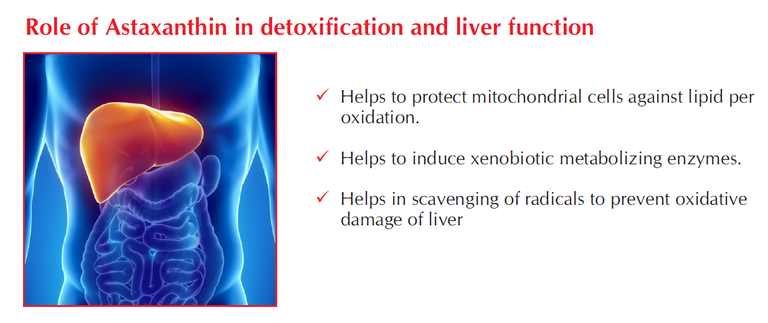
Astaxanthin is much more effective than vitamin E at protecting mitochondria from rat liver cells against lipid peroxidation. Astaxanthin also induces xenobiotic metabolizing enzymes in rat liver, a process that could help prevent carcinogenesis. Astaxanthin can induce xenobiotic metabolizing enzymes in the lung and kidney.
ASTAXANTHIN AND THE IMMUNE RESPONSE - Immune response cells are particularly sensitive to oxidative stress and membrane damage by free radicals because they rely heavily on cell-to-cell communications via cell membrane receptors. Furthermore, the phagocytic action of some of these cells releases free radicals that can rapidly damage these cells if they are not neutralized by antioxidants.
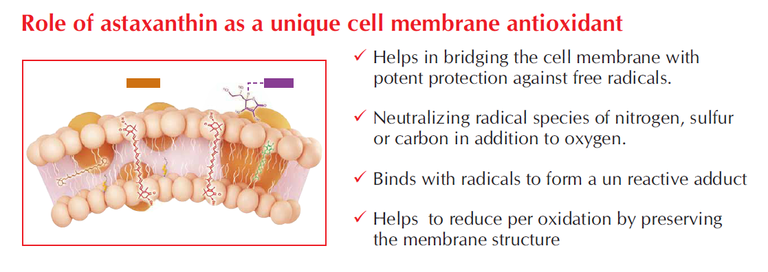
Astaxanthin enhances in vitro antibody production by mouse spleen cells and can also partially restore decreased humeral immune responses in old mice. Other evidence also points to the Immunomodulation activity of Astaxanthin on the proliferation and functions of murine immunocompetent cells. Finally, studies on human blood cells in vitro have demonstrated enhancement by Astaxanthin of immunoglobulin production in response to T-dependent stimuli.
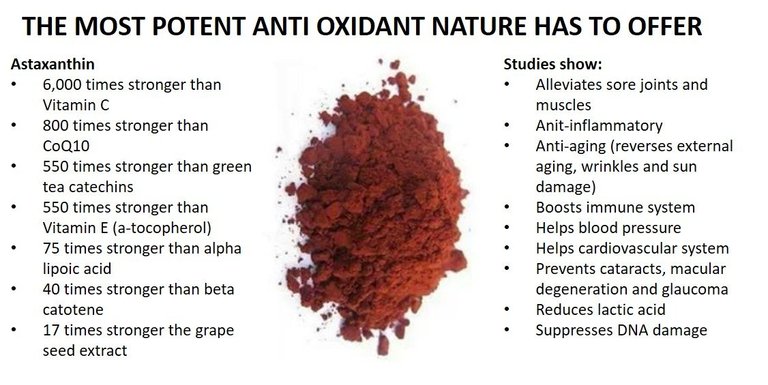
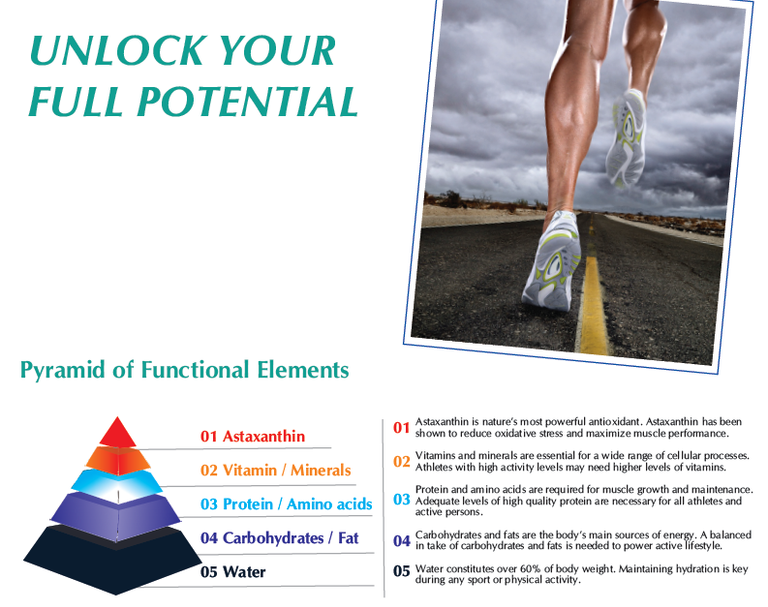

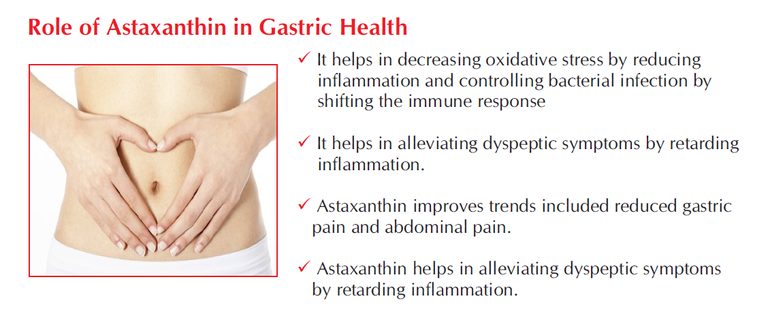
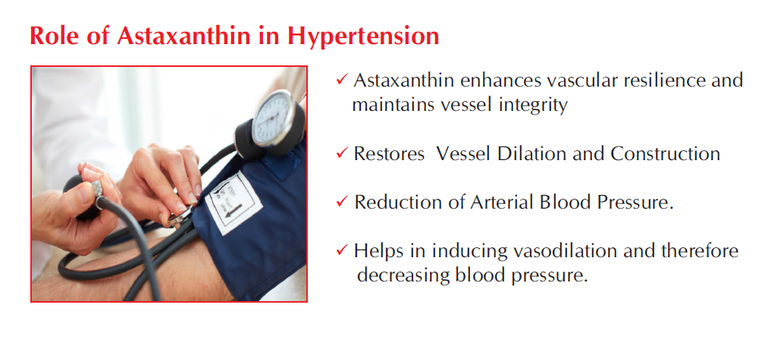
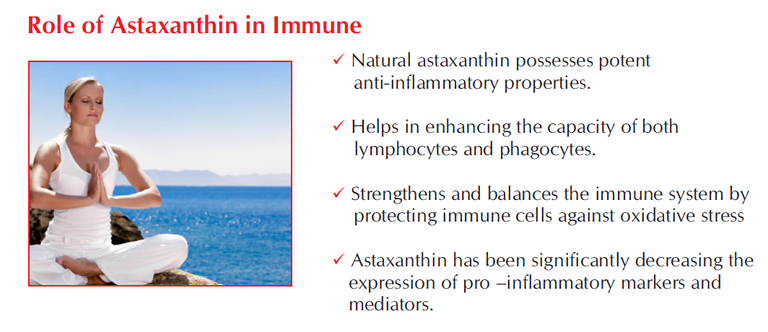
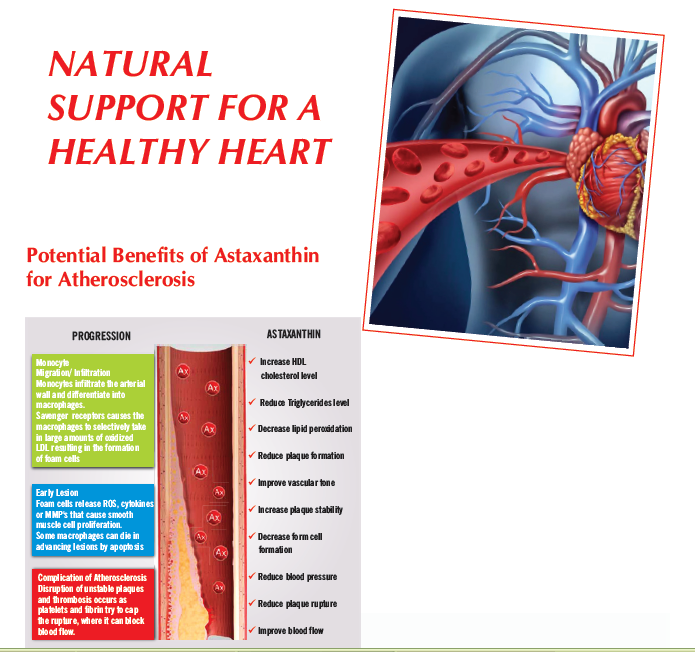
USAGE: As a food supplement combination of antioxidants to improve health and vitality.
CONTRA-INDICATIONS: Product is contra-indicated in persons with Known hypersensitivity to any component of the product hypersensitivity to any component of the product.
RECOMMENDED USAGE: Adults: Two capsules per day along with food. Do not exceed the recommended daily dose.
ADMINISTRATION: Taken by oral route at any time with food.
PRECAUTIONS: Food Supplements must not be used as a substitute for a varied and balanced diet and a healthy lifestyle. This Product is not intended to diagnose, treat, cure or prevent any diseases.
WARNINGS: If you are taking any prescribed medication or has any medical conditions or under age group 17 year always consults doctor or healthcare practitioner before taking supplements.
SIDE EFFECTS: No significant side effects have yet been reported.
STORAGE: Store in a cool, dry and dark place. Keep out of reach of children
SAFETY/TOXICITY: Astaxanthin has demonstrated safety in numerous human clinical trials. In one open-label clinical study on subjects with metabolic syndrome (n=17). Astaxanthin (16 mg/day, for three months) significantly raised blood bilirubin (p≤0.05), potassium (p≤0.05), and creatine kinase (p≤0.01), although all three values remained within normal range. Also, Astaxanthin significantly lowered the liver enzyme gamma-glutamyl transpeptidase (GGTP; p≤0.05). Since the researchers noted this enzyme was abnormally elevated in 11 of the 17 subjects at baseline, this Astaxanthin effect may have been beneficial.
Animal experiments have investigated Astaxanthin at levels well over 120 mg/day in human equivalents, without causing apparent harm. Hoffman-La Roche confirmed its safety with extensive tests, including acute toxicity, mutagenicity, teratogenicity, embryo toxicity, and reproductive toxicity.
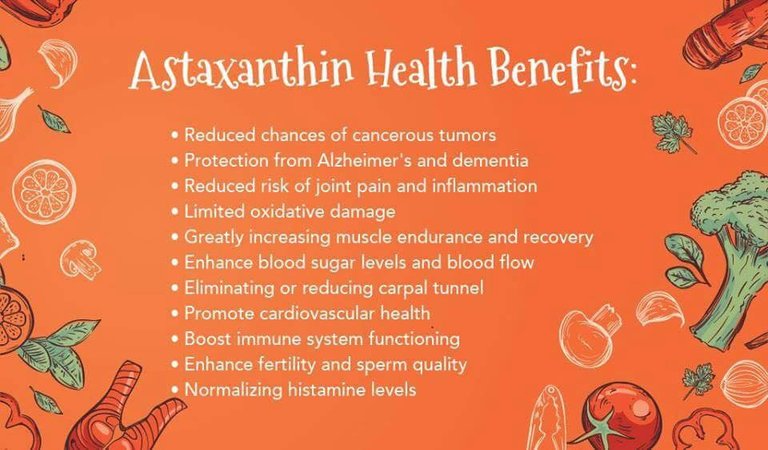
SUGGESTED DOSAGE: The doses of Astaxanthin used in clinical trials have ranged from 1 mg/day to 40 mg/day (with the majority in the 6-12 mg range); single-dose pharmacokinetic studies used up to 100 mg per dose. As a dietary supplement, Astaxanthin should be taken along with fats, with or immediately prior to meals, to ensure its optimal absorption.
CONCLUSION: Astaxanthin, a xanthophyll carotenoid, is a nutrient with unique cell membrane actions and diverse clinical benefits. This molecule neutralizes free radicals or other oxidants by either accepting or donating electrons, and without being destroyed or becoming a pro-oxidant in the process. Its linear, polar-nonpolar-polar molecular layout equips it to precisely insert into the membrane and span its entire width. In this position, Astaxanthin can intercept reactive molecular species within the membrane’s hydrophobic interior and along its hydrophilic boundaries.
Clinically, Astaxanthin has shown diverse benefits, with excellent safety and tolerability. In double-blind, randomized controlled trials (RCTs), Astaxanthin lowered oxidative stress in overweight and obese subjects and in smokers. It blocked oxidative DNA damage, lowered C-reactive protein (CRP) and other inflammation biomarkers, and boosted immunity in the tuberculin skin test.
Astaxanthin lowered triglycerides and raised HDL-cholesterol in another trial and improved blood flow in an experimental microcirculation model. It improved cognition in a small clinical trial and boosted proliferation and differentiation of cultured nerve stem cells. In several Japanese RCTs, Astaxanthin improved visual acuity and eye accommodation. It improved reproductive performance in men and reflux symptoms in H. pylori patients.
In preliminary trials it showed promise for sports performance (soccer). In cultured cells, Astaxanthin protects the mitochondria against endogenous oxygen radicals, conserved their redox (antioxidant) capacity, and enhanced their energy production efficiency. The concentrations used in these cells would be attainable in humans by modest dietary intakes. Astaxanthin clinical success extends beyond protection against oxidative stress and inflammation, to demonstrable promise for slowing age-related functional decline.
Astaxanthin is easily available at Asucre Pure Herbals in capsule, tablet & powder form. Do let us know your requirements so we can send you our offer for the same.
Legal Disclaimer: All the products are for personal use and not for resale. The product description has not been evaluated by the food & drug administration (FDA). The product is not intended to diagnose, treat, cure or prevent any diseases.
Be Our Global Partner! We welcome all trade and wholesale inquiries as we're always looking to serve more regions the world over. If you would like to retail our products at your store/in your region/country, let us know and we will be happy to help you! We welcome all business inquiries and look forward to your response! Do let us know your requirements so we can send you our offer for the same.
Follow us on Social Media
Facebook ~ https://www.facebook.com/asucrepureherbals
Twitter ~ https://twitter.com/asucrewellness
Instagram ~ https://www.instagram.com/asucrepureherbals
LinkedIn ~ https://in.linkedin.com/in/asucrepureherbals
Blog ~ https://asucrewellness.blogspot.in
